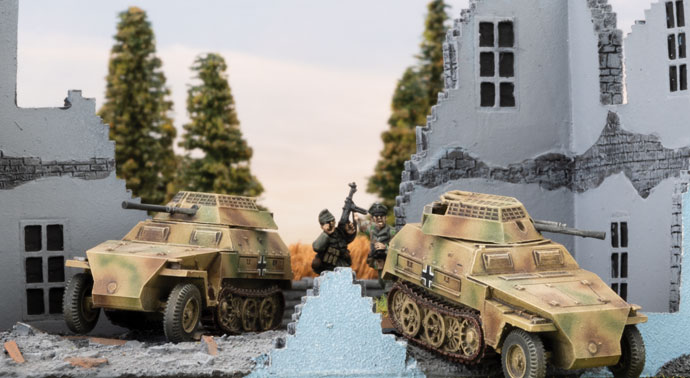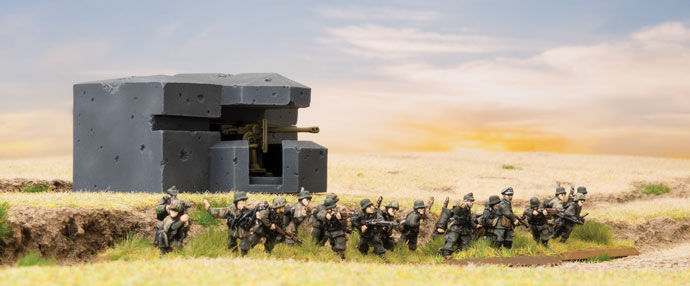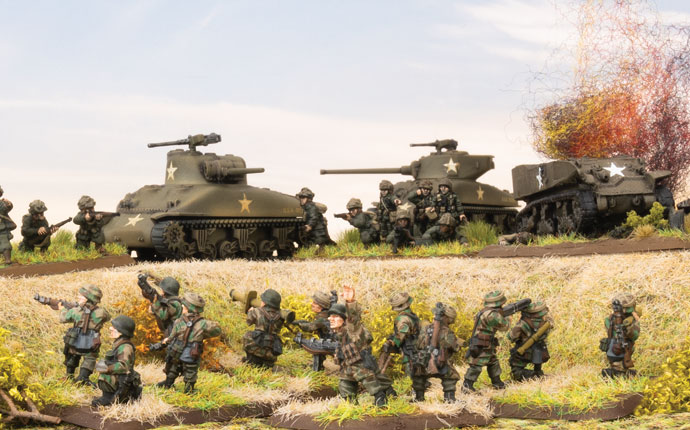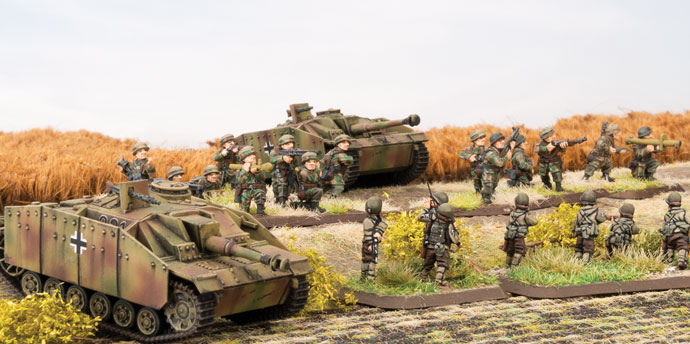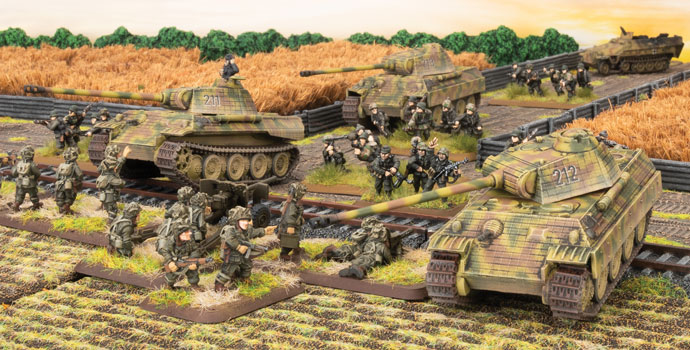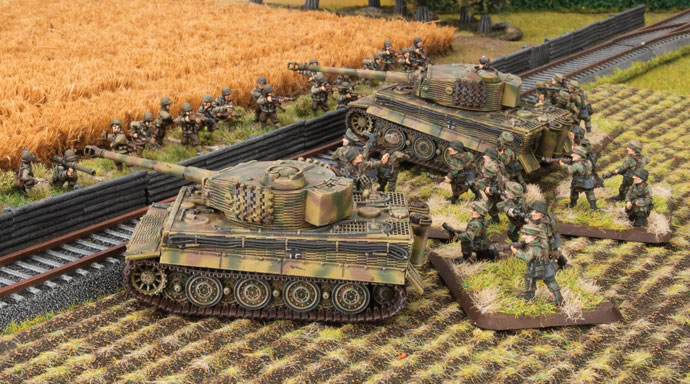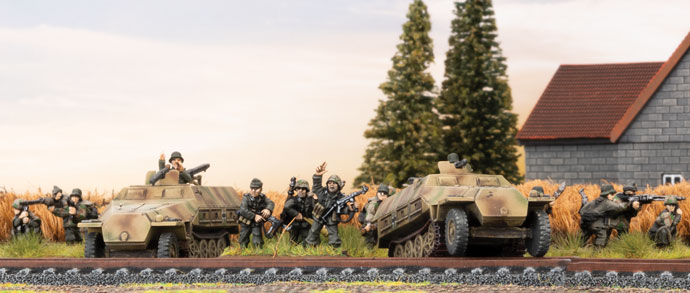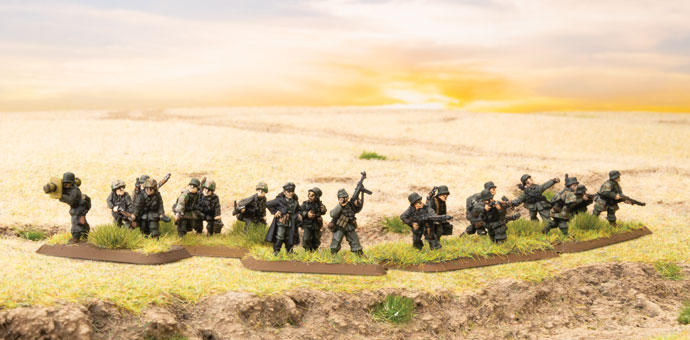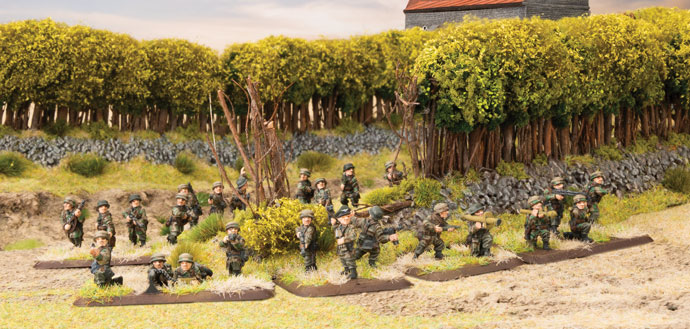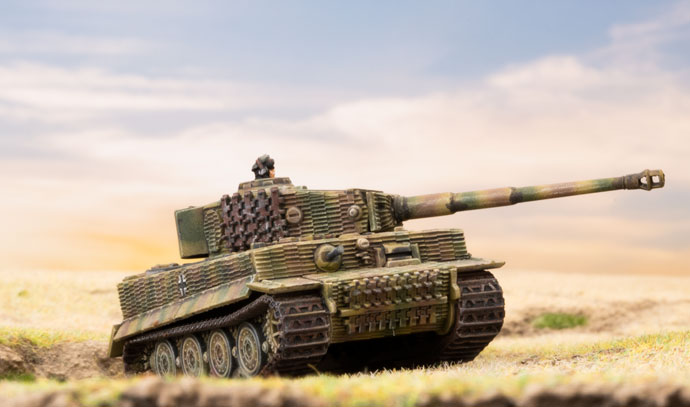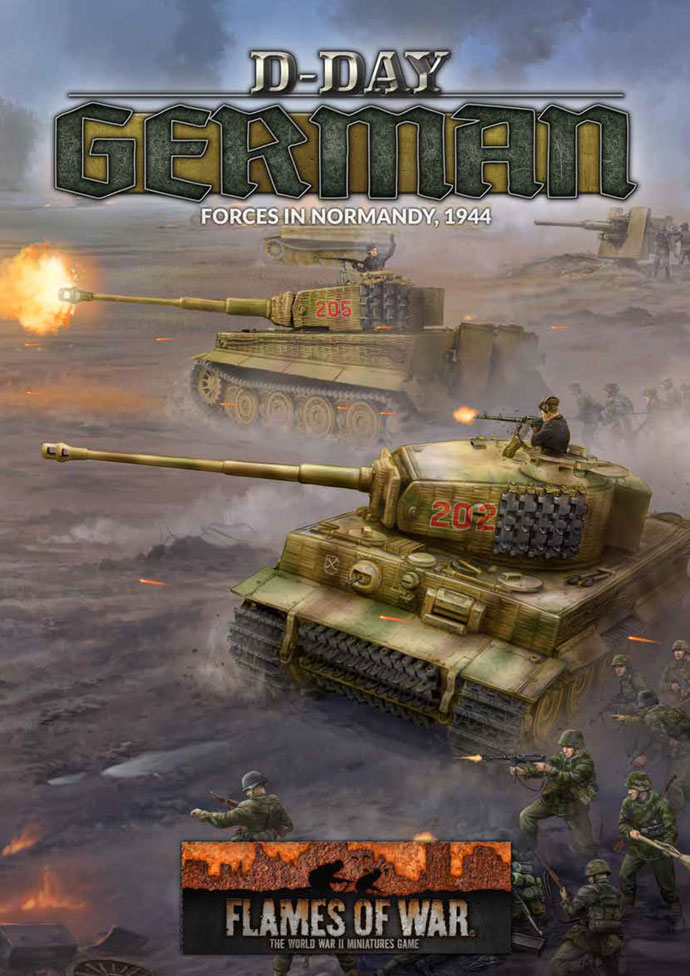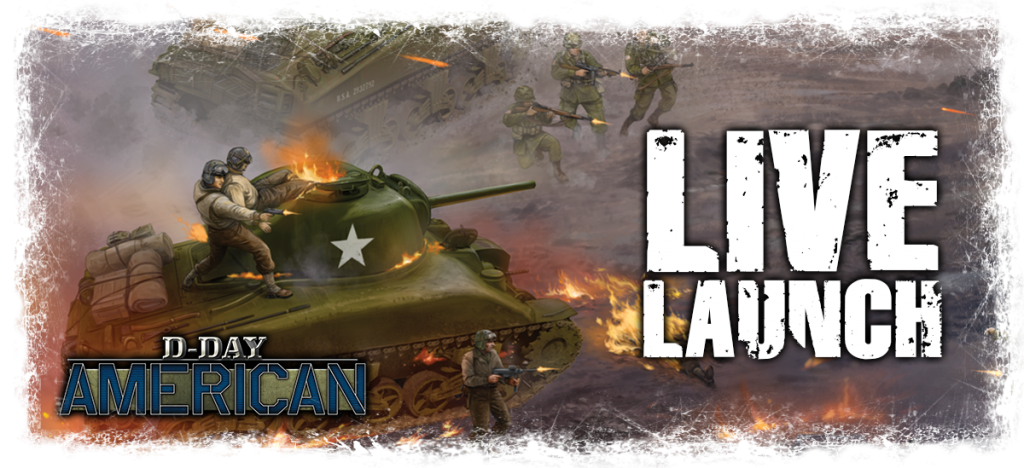Join Alex and Phil as they answer your questions about D-Day: German.
Building a Reconnaissance Company Force
with Phil Yates (Battlefront NZ)
The coolest thing about the new Reconnaissance Company in D-Day: German is its flexibility. It’s similar to an Armoured Panzergrenadier Company in many ways, but lighter, faster, and more flexible.

If I’m building a divisional reserve type force, I want to create a battlegroup mixing tanks and armoured infantry for a flexible approach to battle. The core of the force would be a Reconnaissance Company HQ and a pair of Reconnaissance Platoons, all in light Sd Kfz 250 half-tracks, as an assault force. I could swap one of these out for a normal Armoured Panzergrenadier Platoon to save a few points, but I like the increased firepower of the extra half-tracks and the Scout ability to keep my infantry alive as they work their way forward.
I’d back them up with a Scout Troop of Sd Kfz 250 (2cm) armoured cars to give me some spearhead capability and a useful economy-of-force unit to tie down enemy troops where my main force isn’t. The 8cm Mortar Section and 7.5cm Gun Platoon, give me more Sd Kfz 250 half-track goodness, and relieve my tanks of infantry support duties, making the infantry more self-sufficient. That useful little company comes in at around 44 points if I keep one of the 7.5cm Gun Platoon at two rather than three vehicles. Since I’ve plenty of other guns in my tanks, I don’t think I’ll miss the extra vehicle.
That leaves me a solid 56 points for the tank component. I could go with five Panther tanks for some heavy fire support, but as I envision this as a free-wheeling attack force, I think a company of ten Panzer IV tanks works better. As a separate formation, it’s strong enough to fight its own battle in support of the reconnaissance, and gives me two formations to keep me in the fight. The last point would probably go on the Lucky command card for that extra bit of luck when I really need it.
A defensive force to fill a gap in the line would be a bit different. Here, I’d probably look at adding four Panthers as a powerful reserve striking force (rather than the Panzer IVs), while boosting the core company with a 7.5cm Tank Hunter Platoon to give me more resilience against tanks. Since I don’t need as much mobility, I think I’d also trade in the half-tracks from one platoon to give all of my infantry Panzerfausts. The plan here would be to dig in the platoon without half-tracks with the anti-tank guns on the most vulnerable objective, while a mobile group of all of my half-tracks manoeuvres to keep the enemy at bay until my Panthers arrive, then counterattacks to secure victory.

No matter how you organise it, the Reconnaissance Company has plenty of flexibility and potential (as well as lots of really cute Sd Kfz 250 half-tracks!).
D-Day: German Spotlight
with Phil Yates (Battlefront NZ)
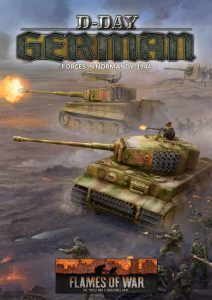
The challenge faced by the German commanders, Rommel and von Rundstedt, was how to combine these disparate forces into a battle-winning force. Should the panzers support the beach defences closely? Or should they operate with complete freedom, seeking to strike a battle-winning blow to cut off and destroy the Allied armies once ashore? What would be the best way to handle the massive Allied superiority in numbers, artillery, especially heavy naval gunfire, and aircraft? They made their choices and failed. Can you do better, defeating the Allied invasion and saving Germany?
What’s In The Book?
Beach Defence Grenadier Company
- Plenty of cost-effective firepower, with lots of ways of getting even more.
- Grenadier platoons can increase their firepower with more machine-guns, added heavy machine-guns, and Panzerfaust and Panzerschreck anti-tank weapons.
- Poorly-trained family men, limited skill, weak in assaults, and easier to hit than most German troops.
- Lots of anti-tank and artillery options with 5cm or 7.5cm anti-tank guns, 8cm and 12 cm mortars, and 7.5cm and 15cm guns.
- Good for holding ground, but don’t expect too much from them.
- Easy to convert from Grenadier Company in Fortress Europe.
Fallschirmjäger Company

- Large platoons of fearless, high-quality infantry.
- Platoons can get extra firepower with heavy machine-guns, and Panzerfaust, and Panzerschreck anti-tank weapons.
- Well defended against tanks with both Panzerfaust and Panzerschreck anti-tank weapons and 7.5cm anti-tank guns.
- Lots of mortars 8cm and 12cm guns.
- Good for holding ground, even better for taking it.
- Exciting new addition to Late War.
Fallschirmjäger StuG Assault Gun Company

- StuG assault gun has better front armour and the same gun as a Panzer IV medium tank, but has no turret so can’t shoot targets to the flanks, and is less effective when assaulting infantry.
- StuH assault howitzer has a brutal gun with 2+ firepower for knocking out enemy guns and infantry.
- StuH assault howitzers operate in a separate platoon and can fire as artillery to support StuG platoons or grenadiers.
- Company can include an integrated Fallschirmjäger or Beach Defence Grenadier Platoon to protect the assault guns.
- Work well with infantry. Assault guns provide fire support. Infantry cover vulnerable flanks.
- Easy to convert from StuG Assault Gun Company in Fortress Europe.
Panther Tank Company

- Medium tanks with enough armour to stop any Allied anti-tank gun and a gun that can easily penetrate any Allied tank, and fast to boot!
- Thinner side and top armour make more vulnerable than heavy tanks like the Tiger.
- Integrated self-propelled anti-aircraft (including Möbelwagen quad 20mm on Panzer IV chassis) help keep Allied aircraft at bay.
- Flexibility. Can swap out platoons of Panther tanks for a platoon of Tiger heavy tanks and a platoon of Panzer IV medium tanks.
- Easily outclasses all opposition, just watch out for your flanks.
- Easy to convert from Panther Tank Company in Fortress Europe.
Panzer IV Tank Company

- Baseline medium tanks. Good armour and better guns than Allied medium tanks.
- Protected ammunition storage and bazooka skirts limit effectiveness of US Bazookas, British PIATs, and Soviet anti-tank rifles.
- High-quality crews give tactical advantages.
- Integrated self-propelled anti-aircraft (including Möbelwagen quad 20mm on Panzer IV chassis) help keep Allied aircraft at bay.
- Flexibility. Can swap out a platoon of Panzer IV tanks for a platoon of Tiger heavy tanks or Panther tanks.
- Gives you the numbers to match the Allies, while still exceeding them in quality.
- Easy to convert from Panzer III & Panzer IV Tank Company in Fortress Europe.
Tiger Tank Company

- Elite heavy tanks with thick armour and powerful guns, yet more mobile than most medium tanks. Ploughs through terrain without a problem.
- Almost immune to medium tanks, artillery, and infantry.
- Integrated self-propelled anti-aircraft to help keep Allied aircraft at bay.
- Expensive quality, but still cheap enough to field a good-sized company.
- Easy to convert from Tiger Tank Company in Fortress Europe.
Armoured Panzergrenadier Company

- Armoured Sd Kfz 251 half-tracks for battlefield mobility, even under fire.
- Infantry can assault while mounted in their half-tracks to overrun light opposition.
- Half-tracked heavy weapons, including 8cm mortars, 2cm AA, 7.5cm guns, and flame-throwers. Grille gives integrated 15cm heavy artillery.
- Flexibility to take dismounted troops. Save points by leaving the half-tracks at home.
- Fast and mobile with plenty of firepower in the attack, solid with massive firepower in the defence.
- Easy to convert from Panzergrenadier Company in Fortress Europe.
Panzergrenadier Company

- High quality infantry.
- MG teams give plenty of firepower.
- Can add Panzerfaust and Panzerschreck anti-tank weapons and 7.5cm anti-tank guns to keep tanks at bay.
- Plenty of integrated weapons, including heavy machine-guns, 8cm and 12cm mortars, 2cm AA, and 7.5cm and 15cm guns.
- Option to include half-tracked heavy weapons for a mobile attacking force.
- Flexibility to take a platoon in half-tracks as a mobile strike force.
- Plenty of firepower to cover attacks or break up enemy attacks. Trained for clever, aggressive attacks and tenacious defence.
- Easy to convert from Panzergrenadier Company in Fortress Europe.
Reconnaissance Company

- Armoured panzergrenadiers mounted in smaller, sneakier, faster Sd Kfz 250 half-tracks.
- Up to 7 half-tracks per platoon for maximum mounted firepower.
- Sneaky scout versions of 8cm mortar and 7.5cm gun half-tracks.
- All-new armoured including:
- 2cm, Puma 5cm, and 7.5cm eight-wheelers.
- Light 2cm half-tracked armoured cars.
- Armoured cars are integrated into formation.
- Flexibility to take armoured and dismounted panzergrenadier platoons.
- Can be integrated into armoured and dismounted panzergrenadier companies.
- Sneak into position, then hit hard and fast.
- Easy to convert from Panzergrenadier Company in Fortress Europe.
Support

- New Jagdpanzer IV tank-hunter. Cheap, effective, mobile.
- Super-deadly long 8.8cm anti-tank guns on cruciform turntable have all-round field of fire.
- Plenty of AA options to counter Allied aircraft. Self-propelled single and quad 2cm, or ground mounted 2cm light or 8.8cm heavy AA guns.
- Lots of artillery choice, with Hummel 15cm and Wespe 10.5cm self-propelled guns, 10.5cm howitzers, and 15cm Nebelwerfer rocket launchers.
- Allied air superiority prevents any German air support in Normandy..
How Do the Germans Play?
The Germans in Normandy have three distinct styles, although they can be profitable mixed and matched for even greater customisation to match your approach.
The first style comes with the Beach Defence Grenadier Company. This formation has a hard crust and a soft gooey centre. It relies entirely on firepower to keep the enemy at bay. If the enemy ever gets through your wall of fire, you will suffer badly. On the other hand, since everything is so cheap, that wall of fire can be very imposing.
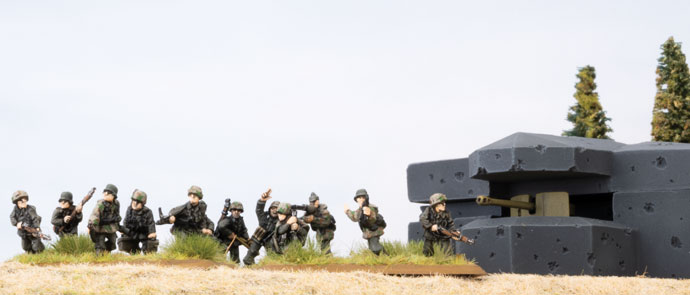
The panzer divisions provide the third style. Whether tanks or panzergrenadiers, these troops have the best equipment in the world, and are highly skilled and won’t quit. Fighting cleverly, these elite troops can tackle greater numbers with ease.
Combining these different styles can also be profitable. You could back your beach defence troops with a hard-hitting armoured battlegroup, or use beach defence troops to hold an objective while your panzers pivot onto the enemy flanks. Your Fallschirmjäger can benefit from the compact firepower of the panzer divisions supporting their attacks, or provide the panzers with a core of shock troops to assault the objective.
In summary, a successful German force will use their superiority in equipment, training, skill, and cleverness, combined with a good dose of aggression, to keep the initiative, hit the enemy in their weak spots, while minimising the enemy’s opportunities to hit them back.
Normandy Campaign Missions
D-Day: Greman includes three new missions and a linked campaign. The first mission is Armoured Fury, a mobile battle where the attackers must push past an enemy spearhead to seize objectives deep in enemy territory, while at the same time preventing the spearhead from pushing on further. It recreates both the German armoured counterattack late on D-Day that pushed between the British spearheads to reach the sea, cutting the British sector in half, and the desperate German counterattack at Mortain, trying to reach the coast and cut off the American breakout.
The second mission is Outflanked. Here the defenders must extend their line to avoid being outflanked by the attackers, reflecting the battles in the week after D-Day before the lines solidified as both sides sought to find an open flank.

These three missions are linked together with two standard missions from the rulebook in a simple campaign where the outcome of one battle has an effect on the next. If the German player can breakout from encirclement in the fifth mission, they win the campaign.
Who are the Warriors
The D-Day: German command card pack includes six warriors: Friedrich Adario, Heinz Auert, Wilhelm Bäder, Heinz Deutsch, Hermann Droppman, and Kurt Knispel. These tough fighters were all awarded the Knight’s Cross, one of Germany’s highest awards.
Kurt Knispel, veteran of years of combat on the Eastern Front, led a platoon of Tiger heavy tanks in Normandy. As the highest scoring tank ace, Knispel rarely missed his target, and refused to leave the battlefield until the task was completed.
Wilhelm Bäder and Hermann Dropmann led grenadiers into battle. Bäder, an ex-artilleryman, made good use of his formation’s mortars and infantry guns, while Dropmann, despite being a colonel in charge of a whole regiment, knocked out five tanks in close combat in a single day, for a career total of at least fifteen tanks.
Friedrich Adario and Heinz Deutsch were both deadly efficient anti-tank commanders. Adario’s long 8.8cm guns were deadly when striking from ambush, destroying well over one hundred British tanks from long range in the Normandy campaign. Deutsch led a StuG assault gun platoon, and ended the war with a claim to 46 Allied tanks destroyed.
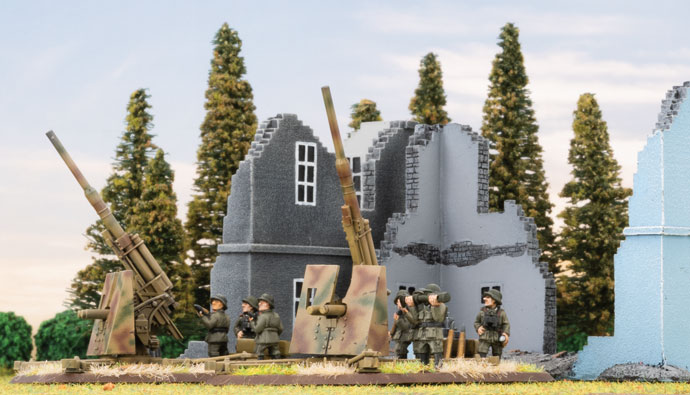
Command Cards
The command cards introduce a new concept, title cards. These cards have the title of a division and a special rule giving the division’s flavour. The key is that you can only have one title in your force. Beach defence troops gain five different varieties from fast bicycle troops to specialist assault battalions, from reluctant ‘volunteers’ from the prisoner of war camps to the higher-quality 352nd Infantry Division. Your beach defence troops can also enhance their firepower with cheaper, but not as well-trained, artillery, anti-aircraft, and anti-tank options.

Other ways in which you can customise your force include crewing your Tiger tanks with aces, allowing your assault guns’ escort platoon to operate as true tank riders, upgrading your infantry to pioneers, armouring your self-propelled anti-aircraft guns, allowing your heavy anti-tank guns to fire as artillery, and creating fortified defences with MG and anti-tank nests, dug-in tanks, and misplaced and forgotten minefields. You can even cause the Allied heavy bombers to score an ‘own goal’, delaying their own reserves!
There are also a few new formations, such as scout companies equipped with various armoured cars.
Last, but not least, the Lucky card gives you a useful one-point filler, giving you that critical re-roll just when you need it.
D-Day: German Live of Digital
D-Day: German is live on Digital- check out everything you need to know about Digital right here…
D-Day: German Live on Forces
D-Day: German is live on Forces, so you can start putting together a force to repel the Allies and secure Fortress Europe!
The D-Day: German Launch is Live!

Over the weekend you can expect to see articles, list builds, videos, battle reports, and we’ll be active on our social media so by all means jump in and check it out.
We’re really excited for everyone to get involved with the D-Day: German launch!
The Battlefront Team
D-Day: German Launch Coming Soon
Join us on September 7th as we launch D-Day: German!
Until then, check out the extensive series of previous launch articles from prior launches, or check out our website at www.flamesofwar.com
D-Day: American Live Launch Landing Page
In July we celebrated the launch of D-Day: American to much fanfare and celebration. You can check out all the great launch day content here:
Releases and Spotlights
Designing Airborne Figures
Fantastic Plastic Forces
D-Day: American Spotlight
Forces and Projects
Andrew’s Rangers Lead the Way
Brandon’s Armoured Rifles
Saving Private Ales
US Recon Cavalry Force
29th Infantry List Tech
Currahee!
Studio Projects I
Studio Projects II
Studio Projects III
Modelling and Painting
Victor’s Big Four Americans
Painting US Airborne- Evan’s Guide
Painting US Infantry- Evan’s Guide
Pete the Wargamer: How to Paint the M5 Stuart
Pete the Wargamer: How to Paint US Airborne
Video
How to: Airborne Assaults
How to: Beach Landing
D-Day: American Direct Order Rotations
D-Day: American Q + A
FUBAR Battle Report
Victor’s ‘Big Four’ Americans
with Victor Pesch
It’s been a “Fury”ous month of painting for me, but there’s nothing like finishing a whole new army ready to hit the table…
Check out the fantastic pictures of Victor’s force over at Big Four…
Andrew’s Rangers Lead the Way
with Andrew Haught
Wayne and I sat down to play a game of Flames Of War and we wanted to do a beach landing. Since I was still working my 29th Infantry Div beach landing Assault Company I decided to do something a little different than what I normally play for this Beach Landing game. I wanted to play Rangers. Rangers in V4 are incredibly cool. They are assault monsters and if they can get in close they will kill everything with their +2 to hit in Assaults.
Now, when brewing up a list for a Beach Landing mission, as an ally force you want to focus on the units that will cycle back onto the table: the infantry units, so I want at least 3 units, but the way the Rangers work I only get two per formation so I need to bring two formation. This is one of the strong aspects of the Rangers since their formations are small you can get multiple company commanders to help motivate your troops and keep your forces moving. With the core troops I wanted to add some artillery in the form of Mortars and Naval Gun Support. And since we are going D-Day let’s get some Duplex Drive tanks via the DD Sherman Command card.
Here is the list I ran against Wayne in our game:|
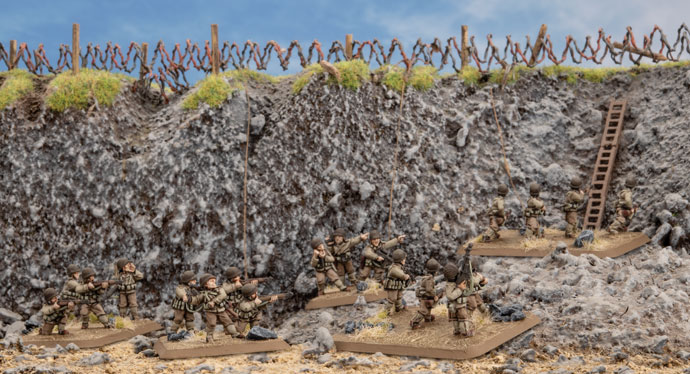
Ranger HQ 1 Point
Ranger Platoon 10 Points
Ranger Platoon 10 Points
Ranger Mortar platoon with 6 guns
Ranger Company 2
Ranger HQ 1 Point
Ranger Platoon 10 Points
Ranger Platoon 10 Points
Support
M4 Sherman Tank Platoon with 4 tanks 14 Points
Command Cards
Lucky 1 Pont
Naval Gun Support 12 Points
Sherman DD 0 Points
If you add it up you can see we were playing below the normal 100 point level, at 75 points. This was due to the fact we were playing in a recorded battle report and we wanted to keep it short. But 100 points is where the game truly shines and if you wanted to add 25 more points to this list I would add the following,
Ranger Company 3
Ranger HQ 1 Point
Ranger Platoon 10 Points
Ranger Platoon 10 Points
Add a fifth tank to the M4 Sherman Platoon +4 Points
That gets you to 100 point easy and you will have even more troops on the table to harass your opponents.
Wayne and I were playing the FUBAR mission found in the D-Day: American book, we wanted to show off the basic mission and give players a look into how the mission is played. We could have played the Pointe Du Hoc Variant rules that would have let us play the beach landing the Rangers ran into on D-Day. Both missions work as FUBAR is a great representation of the Omaha beach landings.
I won’t tell you how the game went as you can watch our battle report video to find that out but I will go into the basic tactics of this list.
This list is all about attacking, you move your infantry in and you overwhelm your target with sheer numbers. During the FUBAR beach landing mission you have to take both objectives but your opponent’s resources are quite limited so try and mass up on both objectives. Your Shermans are limited resources so be careful with them and get them up the beach quickly and have them focus on taking out bunkers, start with the AT bunkers and once they are dealt with move on to the MG nests.
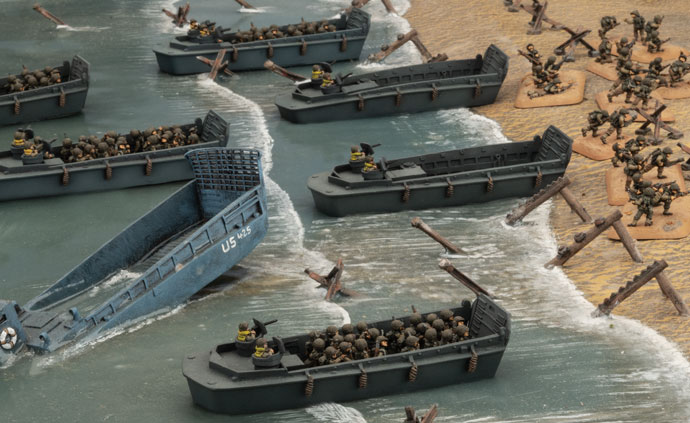
M4 Sherman Company
M4 Sherman Company HQ with 2 Tanks 7 Points
M4 Sherman Tank Platoon with 5 tanks 18 points
M4 Sherman Tank Platoon with 5 tanks 18 points
M4 Sherman (76) Tank Platoon with 5 tanks 23 points
M4 81mm Armoured Mortar Platoon 2 Points
Ranger Company
Ranger HQ 1 Point
Ranger Platoon 10 Points
Ranger Platoon 10 Points
Support
Priest Artillery Battery with 3 Priests 8 Points
Sherman OP 3 Points
There is a hundred points and the Rangers are the perfect include, if you have to defend well you get two full strength Ranger platoons to dig in on the objectives, with their 3+ moral rating they will rally and stay in the fight longer than most other American infantry units. Add in their 2+ to hit in assaults and you have a defending unit your opponent does not want to assault into.
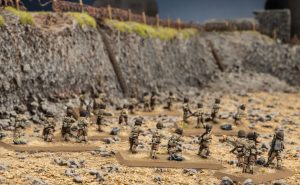
To see the video of our game click here…
Well that’s it for this Army Spotlight, hope to see you on the battlefield,



